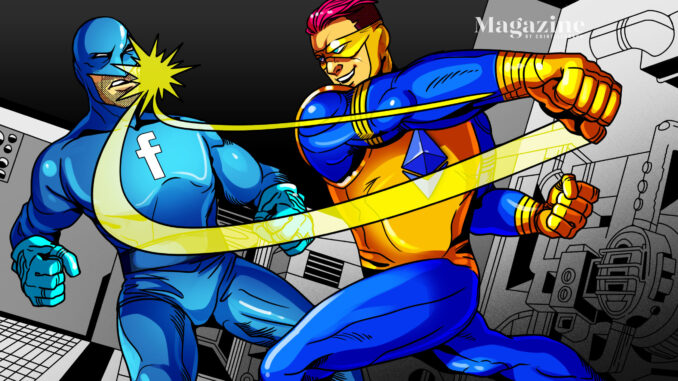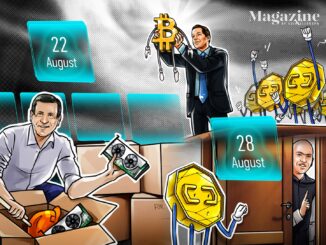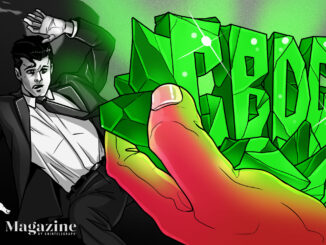
[ad_1]
With Facebook and Microsoft engaged in a virtual land grab, is there still a future for the dream of a Metaverse that’s owned and built by the community?
A dinosaur walks into a bar, orders a whiskey neat and sits down with a pink elephant and a purple, hard-to-place obscure anime character. They watch a live NBA game. A good time is had by all.
This is no joke. For one major crypto fund manager referred to as “Simon,” who prefers to remain anonymous (and not offer investment advice), that night in 2020 — which resembled the famous bar scene on Mos Eisley in Star Wars — was the moment when the light bulb went off. Decentraland. This is a real thing, he thought.
Virtual, community-built worlds such as Decentraland and The Sandbox stem from a gaming market that allows people to host virtual events and buy or rent digital real estate. These nonfungible token Metaverse platforms bridge the real world with the surreal in what The Sandbox has described as a “player-owned economy.”
The Sandbox last week raised $93 million from Soft Bank’s Vision Fund 2, and NFT sales exceeded $10 billion in Q3 of 2021. We are now at the dawn of the Metaverse era. Celebrities, including rappers like Snoop Dogg, and luxury fashion brands are all getting in on the NFT game to monetize their products, images and personas.
It has been a huge year for the space, and the pandemic has helped the cultural adoption of the concept of the Metaverse. “We have all kind of already lived a Metaverse life on Zoom, over the last two years. The Metaverse is where it all ends,” notes Robby Yung, CEO of Animoca Brands — which owns The Sandbox and is a major shareholder in CryptoKitties and NBA Top Shot creator Dapper Labs.
It’s also more than just a game: “What does it mean to plug into the Metaverse? It’s more of a philosophical question of how much of my time will I dedicate to this place.”

Big money is being thrown around. Along with Facebook, Microsoft is muscling in too. Whoever becomes dominant early on can grab the early network effects to become a gigantic player. While Facebook’s investors might be concerned by the $10 billion the company is spending on the Metaverse this year, why can’t Facebook join this glorious virtual world?
There is some logic behind the rebrand to Meta, considering it bought Instagram and WhatsApp in 2012 and 2014, respectively, as well as VR headset company Oculus in that latter year. It makes sense for that virtual reality play, and Facebook has the money and the network effects to attract new gamers and interest to the space. Many diehard cryptopreneurs and investors are enjoying the mass adoption brought on in 2021 by the NFT craze, and Facebook would help that mass adoption goal.
But it also raises plenty of questions. Few are clear on what exactly the social media giant’s plans are, but unlike Decentraland, pundits expect data to be collected and that the platform will be centralized.
The social media giant could pose a big threat to a community-run Metaverse. Should a centralized company like Facebook — which constantly faces antitrust questions and is criticized from all quarters over privacy issues and spreading misinformation and division — be allowed to take control of the Metaverse?
There are a lot of cultural and economic factors at play. We consider them from three perspectives: The Metaverse Investors, The Metaverse Founders and The Metaverse Gamers. What is the Metaverse, and where is it going? And could — or should — Facebook join this metaphysical universe?

For many (even within Cryptoland), it’s probably still hard to understand what’s driving the Metaverse. Despite the foundations being built, it’s still very much a concept at this stage — one reflecting our inner hopes and dreams, a vast cartoonish digital playground enmeshed with our physical world.
According to Mike Rubin, founder of Dreamium Labs and creator of the Dreamscape Open Metaverse initiative, the term is being misused. “The term is being both improperly and overly used to describe products and, as we’ve just seen with the Facebook rebrand, a company,” he says.
This is one of the problems with Facebook’s play: “We believe there can only be one Metaverse, and to be part of it, there has to be interconnectivity and self-sovereignty of identity,” Rubin says.
“So, in practice, companies and products that are calling themselves ‘a metaverse’ are simply referring to apps and worlds — or in the case of Facebook, its own universe. Perhaps in the future, if they adopt a self-sovereign universal identity system, they can become part of the Metaverse.”
Central to the idea of the Metaverse is that each person will have their own interactive avatar that exists outside of any walled garden or service within the Metaverse. “Owning your avatar and all its data is a fundamental tenet,” he says. “If your interactive digital identity is not transportable to a destination, then, by definition, that destination can not be part of the Metaverse.” So, a Metaverse carved up and controlled by companies is not a Metaverse.
“That is the basis of [each person’s] digital identity, which enables all their interactions and how they are represented in each interconnected experience,” argues Rubin.
Digital ownership is made possible through NFTs, and blockchain technology encourages individuals to build the Metaverse, in part because they own whatever they create.

Logically, of course, Facebook could still muscle in the Metaverse due purely to its network effects, but this will become a war of ecosystems, not just companies.
The key battle will be between Facebook alongside other corporations seeking to control the Metaverse and the crypto kids who want it to be community-built, -owned and -run. The history of the internet suggests that the companies are likely to get the upper hand — unless the decentralized nature of blockchain technology has dramatically altered the balance.
Rubin, a tech veteran, argues that “Since no one entity should control such a vital system to the Metaverse, we are calling on the entire ecosystem to join together in a community-owned and -operated open Metaverse: the Dreamscape MetaDAO. Only together can we accelerate into the first few innings of the Metaverse era.”
Whether a decentralized autonomous organization is more or less likely to succeed than Facebook is an interesting question that may depend on eventual commercial partnerships, platform creations and gaming preferences.
Part of the problem is that the Metaverse is still being built, so rent-seeking is still possible. For Rubin, a baseball analogy is apt: “We are still in warmups, taking batting practice. The game has not even started, but there are already lots of players on the field getting ready.”

Interoperable gaming and the adoption rubric
The Metaverse has the potential to change the way we work. Decentraland and The Sandbox, for example, enable players to monetize their time spent in the Metaverse in different ways, also known as play-to-earn.
For Mitch Penman-Allen, co-founder of play-to-earn startup Perion, Facebook doesn’t fit into the definition of the Metaverse. “The Metaverse is the idea that we are building interoperable digital networks founded upon digital asset ownership and platform-agnostic useability,” he says.
Perion is a digital gaming guild that buys and leases NFT assets to gamers who use them to get the best returns, “bringing staking into the gaming realm.” Co-founder Amos Whitewolf was the No.1 player on Axie Infinity for several months in 2021, and he has reinvested those play-to-earn winnings into his startup. He even got his 13-, 15- and 17-year-old sisters into play-to-earn to make pocket money.
“The people who really understand this are the crypto-natives who have had a strong focus on what’s been happening on the ground since the beginning. The people that will pick up on this space fast are going to be gamers — nothing is new here for a gamer other than real ownership. The fight for decentralized ownership of the Metaverse isn’t new.”
He notes that the first NFT project created on the Ethereum blockchain, “Etheria,” was a decentralized virtual world where players owned tiles and farmed them for blocks to build things. It had the intention of offering an alternative to “whatever Google and Facebook come up with” in regard to the Metaverse.
In November 2017, Dapper Labs’ CryptoKitties popularized the then-revolutionary concept of NFTs, with co-founder Mik Naayem telling Magazine last year that it was a strategic play.
“The reason we decided to go for entertainment — specifically games — is because we felt that it’s just a much easier way to introduce folks to decentralization,” he said. “Gamers are the perfect target market, as they already understand virtual currencies and virtual worlds.”
Gaming leading to crypto adoption has been a longstanding crypto prophecy that seemed to finally dawn in 2021, argues Whitewolf. “Gaming is where the next wave of people onboarded to crypto is going to happen. People understand games — they don’t need to learn finance or tech to be a part of this movement. In-game assets are not a new concept. Ownership and truly interoperable assets are the next step.”

Incentivization is the key to the community-built Metaverse
The play-to-earn model saw Filipinos starting to play games en masse during the pandemic rather than seeking manual work or a call center job, with Axie Infinity the “godfather of the play-to-earn model,” according to fund manager Simon. This social phenomenon, while not unique to the Philippines, is certainly most pronounced there, with a considerable amount of Metamask’s growth this year coming from the country. Discord (AKA “Slack for gaming”) groups now feature tens of thousands of members from the Philippines, and there are now more SLP (one of Axie Infinity’s tokens) wallets than credit cards in the Philippines.
Adoption is a mechanism of a “good play-to-earn model and a good game to play,” according to Yung — a tech veteran from the online gaming industry, the majority shareholder of The Sandbox and an investor in Decentraland.
Economics and being able to earn in the Metaverse will also be an important part of building the ecosystem. Filipino gamer “Water Emperor” got into NFTs and playing Axie Infinity due to the pandemic, and he joined a guild run by Whitewolf in July 2021, renting an NFT to play the game as a “scholar.” In Metaverse parlance, scholars play the game with someone else’s NFT with a revenue split model.
Water Emperor uses this model to “pay for my tuition fees” and hopes to become a doctor one day. His parents are supportive and hope to invest in crypto soon too. In a country with a political system as volatile as the Philippines, and with mass unemployment during the pandemic, it is easy to see why this new financial earning capacity offers new hope for Filipino gamers.

“Axie Infinity — it’s a good game, similar to card games when I was a kid. Constantly changing, another universe is always changing,” he says. “That is why I play, to open windows to explore, and it helps me to complete my studies.”
Most people play on mobile phones in the Philippines, and high internet fees affect the profitability of gaming at times. Nevertheless, he salvaged 2021 by turning his passion for gaming into a career. Crypto economics allowed that to happen.
In short, incentivization is the key to a community-built Metaverse. “We are at the beginning. Crypto-asset protocols have created the infrastructure the Metaverse will require,” says Whitewolf.
“The Metaverse doesn’t start in virtual reality — it starts with ownership of assets, [the] ability for anyone to create and trade value. VR comes later as the technology becomes available.”
Multiple metaverses already exist
For Simon the crypto fund manager, his interest started with Decentraland — walking around a virtual bar and watching a live NBA game with random avatars. It was then that the “penny dropped.” For him, this is the next step for the internet and social engagement. “Young people are more digitally engaged, and people living in suboptimal living standards could live more happily in a digital world.”

On that measure, it’s also obvious how Facebook fits in this world. Facebookers are already living online. Posts — and more importantly, how often a person posts — can often reveal much about a person, from mental health to happiness and their attitudes toward privacy.
Facebook clearly believes the Metaverse is the next evolution of social media, which puts it in the driving seat based on its users, but its implementation of play-to-earn will also be important to its success globally.
There are already multiple socioeconomic metaverses, and this may play in Facebook’s favor if the right to play is free and its existing network effects hold strong. In The Sandbox and in Decentraland, there is a finite amount of square footage, and corporations will likely buy up much of that land, according to Simon.
Gas fees can also be prohibitive, especially on Ethereum, where it costs a fortune to mint and trade NFTs, locking out large parts of the population. As alternative networks like Solana, Cardano and Polkadot are used, and as Ethereum sidechains are built and the blockchain moves to proof-of-stake, the barriers to entry will lower.
“NFTs are also currently relatively inaccessible to non-crypto natives. This is a limitation of the infrastructure that NFTs are released on,” argues Whitewolf. In some ways, this is a race to widespread adoption.
Corporations are already muscling into the Metaverse and taking it away from the people, replicating the divide in the real world of the haves and have-nots. Simon notes that growth is not all egalitarian. Whales were buying up blocks in Decentraland for “$20,000 in May that are now about $800,000.”
Corporations such as 1980s gaming superstar Atari have also invested heavily in Decentraland and The Sandbox. “This is already beyond a poor man’s game,” he notes. “As real-world advertising progresses further, land will be more valuable than Times Square,” opines the crypto fund manager.

The Metaverse is the antithesis of Facebook
The term “metaverse” originates from Neal Stephenson’s 1992 novel Snow Crash. It’s one of Facebook founder Mark Zuckerberg’s favorite novels, and he reportedly used to give it to all new hires.
Animoca Brand’s Yung says the book was also his own “gateway drug into tech and angel investing,” and his first angel investment in 1997 was based on building a Snow Crash-style Metaverse. The CEO of that startup is now an investor in The Sandbox — hopefully, a good harbinger for the crypto kids long waiting for this moment of evolution.
Yung believes that the Metaverse is the antithesis of Facebook. “Sci-fi always reached for that idea. Now, we have the tools. A blockchain economy makes it real,” he says, adding that crypto has managed to stay one step ahead of corporate control so far:
“Crypto ventures needed to move forward as fast as possible so that the behemoths couldn’t buy them. Even Facebook and Google can longer afford to buy Ethereum.”
Whitewolf is not sure where the Metaverse is headed, but he knows it’s going to be huge and erase the barriers between developing economies and developed ones. “Crypto gaming is going to massively onboard billions onto blockchain. The crypto narrative around banking the bankless has never been so realistic,” he says.

Reddit co-founder Alexis Ohanian said recently that the Metaverse is being built by the community, not corporations, and he hopes that it stays that way
“Right now, there is this bottom-up movement to create the Metaverse. You’re seeing a lot of this happening in the crypto community. You’re seeing a lot of people building what I think is, what most of us hope will become, a much more organic type of world rather than a top-down Facebook-imposed one.”
For Rubin, the key element has always been open community and open-source network effects, which he believes are more powerful than any corporation. “We don’t see it as a battle between Facebook and crypto kids, per se. The latter will approach their efforts with decentralization at the forefront, while the large established tech companies are going to see blockchain and crypto as a necessary ‘bolt-on’ as opposed to being core,” he says.
“Time will tell which approach gains adoption as well as sustainability. We have made our bet that a decentralized, open and community-owned blockchain foundational layer is going to win.”
[ad_2]
Source link







 Bitcoin
Bitcoin  Ethereum
Ethereum  Tether
Tether  XRP
XRP  Solana
Solana  USDC
USDC  TRON
TRON  Dogecoin
Dogecoin  Lido Staked Ether
Lido Staked Ether
Be the first to comment